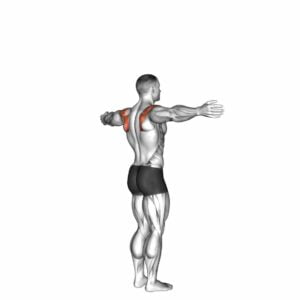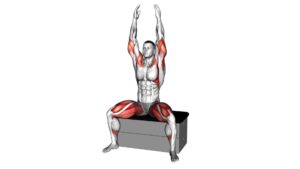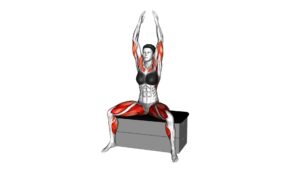Shoulder – Abduction – Video Exercise Guide & Tips

Looking to strengthen your shoulder muscles? Our video exercise guide and tips will help you master the technique of shoulder abduction.
Watch This Exercise Video
With clear demonstrations and expert advice, you'll learn the proper form and essential equipment needed for effective workouts.
Whether you're a beginner or an experienced lifter, we've got you covered with beginner-friendly and advanced exercises.
Get ready to maximize your shoulder abduction results with our handy tips.
Let's get started!
Key Takeaways
- Shoulder abduction exercises strengthen the muscles in the shoulders and upper back.
- These exercises improve shoulder stability and reduce the risk of injuries.
- They enhance overall upper body strength and increase range of motion in the shoulders.
- Shoulder abduction exercises also improve posture and alleviate tension and pain in the upper back.
Benefits of Shoulder Abduction Exercises
You can experience numerous benefits from performing shoulder abduction exercises. Shoulder abduction exercises are designed to strengthen the muscles in your shoulders, specifically the deltoids and the muscles in your upper back. By regularly incorporating these exercises into your workout routine, you can improve your shoulder stability, increase your range of motion, and enhance your overall upper body strength.
One of the main benefits of shoulder abduction exercises is improved shoulder stability. These exercises target the muscles that help stabilize your shoulder joint, reducing the risk of injuries and enhancing your overall shoulder function. Additionally, performing shoulder abduction exercises can help improve your posture by strengthening the muscles in your upper back, which can alleviate tension and pain.
Another benefit of shoulder abduction exercises is increased range of motion. These exercises involve lifting your arms away from your body, which helps to stretch and strengthen the muscles responsible for shoulder movement. By regularly performing shoulder abduction exercises, you can gradually increase your shoulder flexibility and improve your ability to perform everyday tasks and sports activities.
Incorporating shoulder abduction exercises into your workout routine can also enhance your overall upper body strength. These exercises target the muscles in your shoulders, upper back, and arms, helping to build lean muscle mass and improve muscular endurance. This can lead to improved performance in activities that require upper body strength, such as lifting, pushing, and pulling.
Proper Form and Technique for Shoulder Abduction
To perform shoulder abduction exercises with proper form and technique, ensure that your arms are lifted away from your body in a controlled manner. This will help you avoid common mistakes and reduce the risk of common injuries associated with shoulder abduction workouts. Here are some tips to help you maintain proper form and technique:
- Stand tall with your feet shoulder-width apart.
- Keep your core engaged and maintain a neutral spine throughout the exercise.
- Start with light weights and gradually increase the resistance as your strength improves.
- Avoid using momentum to lift the weights; instead, focus on using your shoulder muscles to perform the movement.
- Control the movement both on the way up and on the way down to maximize the benefits and minimize the risk of injury.
By following these guidelines, you'll ensure that your shoulder abduction exercises are effective and safe.
Now that you understand the importance of proper form and technique, let's move on to the next section, where we'll discuss the essential equipment needed for shoulder abduction workouts.
Essential Equipment for Shoulder Abduction Workouts
To effectively perform shoulder abduction workouts, it's essential to have the right equipment. Having the appropriate shoulder abduction equipment won't only enhance the effectiveness of your workouts but also ensure that you maintain proper form and technique.
One of the most important pieces of equipment for shoulder abduction exercises is resistance bands. These bands provide the necessary resistance to strengthen your shoulder muscles and improve their range of motion. You can choose from various levels of resistance to suit your fitness level and progression.
Another useful equipment for shoulder abduction workouts is dumbbells. They allow you to add weight to your exercises, increasing the challenge and promoting muscle growth.
Additionally, an adjustable bench is beneficial for providing stability and support during seated shoulder abduction exercises.
Lastly, a yoga mat or exercise mat is useful for added comfort and traction while performing shoulder abduction exercises on the floor.
With the right shoulder abduction equipment, you can maximize the benefits of your workouts and achieve your fitness goals.
Now, let's move on to the next section and explore beginner-friendly shoulder abduction exercises.
Beginner-Friendly Shoulder Abduction Exercises
Now that you're ready to start incorporating shoulder abduction exercises into your workout routine, it's important to focus on proper form techniques to avoid injury.
Luckily, there are plenty of beginner-friendly exercises that require no equipment, making them accessible for everyone.
As you progress, you can gradually increase the difficulty level to continue challenging your muscles and improving your shoulder strength and stability.
Proper Form Techniques
Mastering proper form techniques is essential for beginners to effectively perform shoulder abduction exercises. To ensure you're performing these exercises correctly and minimizing the risk of injury, keep the following tips in mind:
- Common Mistakes:
- Avoid using momentum to lift your arms. Instead, focus on engaging the shoulder muscles.
- Don't shrug your shoulders. Keep them relaxed and pulled down.
- Avoid leaning or tilting your body to one side. Stay upright and maintain proper alignment.
- Don't lock your elbows at the top of the movement. Keep a slight bend to protect your joints.
- Avoid excessively lifting your arms beyond your comfortable range of motion.
By following these proper form techniques, you'll maximize the effectiveness of your shoulder abduction exercises and reduce the risk of injury.
Now, let's move on to the next section about equipment-free variations.
Equipment-Free Variations
If you're a beginner, you can try equipment-free variations of shoulder abduction exercises to strengthen your shoulder muscles. These exercises are perfect for those who don't have access to resistance bands or other equipment.
One simple variation is the standing shoulder abduction exercise. To perform this exercise, start by standing with your feet shoulder-width apart and your arms relaxed at your sides. Then, slowly raise your arms out to the sides until they're parallel to the ground. Hold this position for a moment before lowering your arms back down. This exercise targets the same muscles as the traditional shoulder abduction exercise but without the need for any equipment.
Now, let's move on to the progression and difficulty levels of these exercises.
Progression and Difficulty Levels
To progress and increase the difficulty of beginner-friendly shoulder abduction exercises, you can incorporate additional resistance or weights. This will challenge your muscles and help you improve your strength and stability.
However, it's important to keep safety precautions in mind when progressing to more difficult levels. Here are some tips to help you safely progress and increase the difficulty of your shoulder abduction exercises:
- Gradually increase the weight or resistance used.
- Perform exercises with slower and controlled movements.
- Increase the number of repetitions or sets.
- Incorporate variations such as standing or single-arm exercises.
- Utilize resistance bands or dumbbells for added challenge.
Remember to always listen to your body and consult with a professional if you experience any pain or discomfort. Progression levels should be based on your individual fitness level and abilities.
Stay consistent, challenge yourself, and enjoy the benefits of stronger and more toned shoulder muscles.
Advanced Shoulder Abduction Exercises for Experienced Lifters
Now that you've mastered the beginner-friendly shoulder abduction exercises, it's time to take your shoulder training to the next level with advanced variations.
These exercises are specifically designed for experienced lifters who are looking to challenge their strength, stability, and range of motion.
Exercise Variations for Pros
Start by incorporating advanced shoulder abduction exercises into your workout routine to challenge your muscles and take your lifting to the next level. Here are some exercise variations for pros to help you achieve maximum results:
- Resistance Band Shoulder Abduction: Attach a resistance band to a stable object and stand facing sideways. Hold the band with your hand and raise your arm out to the side against the resistance.
- Dumbbell Lateral Raise: Hold a dumbbell in each hand and stand with your feet shoulder-width apart. Lift the dumbbells out to the sides until your arms are parallel to the floor.
- Cable Shoulder Abduction: Stand facing a cable machine with the handle attached at shoulder height. Grab the handle and lift your arm out to the side against the resistance.
- Single-Arm Dumbbell Snatch: Hold a dumbbell in one hand between your legs. Explosively extend your hips and knees while shrugging your shoulder to raise the dumbbell overhead.
- Arnold Press: Start with the dumbbells at shoulder height, palms facing you. Press the dumbbells overhead while rotating your palms away from you.
Benefits of Advanced Exercises
For experienced lifters, incorporating advanced exercises for shoulder abduction can provide significant benefits to your training regimen. Advanced exercise modifications allow you to challenge your muscles in new ways and break through plateaus. These exercises target the muscles involved in shoulder abduction more intensely, helping you build strength, stability, and mobility in the shoulder joint.
By performing advanced shoulder abduction exercises, you can improve your overall shoulder strength and enhance your performance in other upper body exercises. However, it's important to be mindful of common mistakes that can occur during these exercises. One common mistake is using too much weight, which can put excessive strain on the shoulder joint. Another mistake is using improper form, which can lead to injury.
It's crucial to maintain proper technique and start with lighter weights before progressing to heavier loads. Remember to consult with a qualified fitness professional to ensure you're performing advanced exercises correctly and safely.
Tips for Maximizing Shoulder Abduction Results
To achieve maximum results in shoulder abduction, focus on maintaining proper form throughout the exercise while engaging the target muscles. Here are some tips to help you maximize your gains and avoid common mistakes:
- Warm up: Prior to starting your shoulder abduction exercise, make sure to warm up your muscles with some light cardio or dynamic stretching. This will help increase blood flow and flexibility, reducing the risk of injury and improving your range of motion.
- Start with lighter weights: It's important to start with weights that you can handle comfortably. Gradually increase the weight as your strength and endurance improve. This will help prevent strain and promote steady progress.
- Engage your core: To maximize the effectiveness of your shoulder abduction exercise, engage your core muscles by maintaining a stable and upright posture. This won't only target your shoulder muscles more effectively but also help protect your lower back.
- Control the movement: Avoid using momentum to swing the weights up and down. Instead, focus on controlling the movement throughout the entire range of motion. This will ensure that your shoulder muscles are properly engaged and receiving the full benefit of the exercise.
- Breathe properly: Remember to breathe steadily and rhythmically throughout the exercise. Inhale as you lower the weights and exhale as you raise them. This will help maintain proper form and prevent unnecessary strain.
By following these tips, you can maximize your shoulder abduction results and achieve the gains you desire. Remember to listen to your body and adjust the intensity of your workout accordingly.
Happy exercising!
Frequently Asked Questions
How Often Should I Perform Shoulder Abduction Exercises?
To get the most out of shoulder abduction exercises, it's important to know how often to perform them. Regularly incorporating shoulder abduction exercises into your routine can help strengthen the muscles around your shoulder joint and improve range of motion.
However, the frequency of these exercises may vary depending on your individual needs and goals. It's best to consult with a healthcare professional or a qualified fitness trainer to determine the appropriate frequency for you.
Can Shoulder Abduction Exercises Help With Shoulder Impingement?
Shoulder abduction exercises can be beneficial for shoulder impingement treatment. By regularly performing these exercises, you can help improve shoulder joint mobility and strengthen the surrounding muscles.
Shoulder abduction exercises specifically target the deltoid muscles and help to stabilize the shoulder joint. This can alleviate impingement symptoms and promote better shoulder function.
It's important to consult with a healthcare professional or physical therapist to ensure proper form and technique while performing these exercises.
Are There Any Modifications or Alternative Exercises for Individuals With Shoulder Injuries?
If you're dealing with shoulder injuries, there are modifications and alternative exercises available to aid in your shoulder rehabilitation and strengthening.
It's important to consult with a healthcare professional or a physical therapist who can guide you in choosing the right exercises for your specific condition. They can provide you with a tailored exercise plan that focuses on shoulder mobility and strength while avoiding further injury.
Remember to prioritize safety and listen to your body throughout your rehabilitation journey.
What Other Muscle Groups Are Involved in Shoulder Abduction Exercises?
Shoulder abduction exercises not only target the primary muscles involved in the movement, but also engage other important muscle groups.
When performing shoulder abduction exercises, you activate the deltoids, specifically the middle fibers, which are responsible for lifting the arm away from the body.
Additionally, the supraspinatus muscle in the rotator cuff plays a crucial role in stabilizing the shoulder joint during abduction movements.
Engaging these muscle groups through the best shoulder abduction exercises can lead to improved shoulder strength, stability, and overall functionality.
Can Shoulder Abduction Exercises Improve My Posture?
Shoulder abduction exercises can have a positive impact on your posture.
By strengthening the muscles involved in shoulder abduction, such as the deltoids and rotator cuff, you can improve your overall shoulder stability and alignment.
This can help counteract the effects of poor posture and promote a more upright and balanced position.
Some of the best shoulder abduction exercises include lateral raises, cable lateral raises, and dumbbell lateral raises.
Incorporating these exercises into your routine can contribute to better posture.
Conclusion
In conclusion, shoulder abduction exercises are beneficial for improving shoulder strength and flexibility.
By using proper form and technique, along with the right equipment, individuals can perform these exercises safely and effectively.
Whether you're a beginner or an experienced lifter, there are exercises suitable for every level.
By following these tips and incorporating shoulder abduction exercises into your fitness routine, you can maximize your results and achieve a stronger and more mobile shoulder joint.

Author
Years ago, the spark of my life’s passion ignited in my mind the moment I stepped into the local gym for the first time. The inaugural bead of perspiration, the initial endeavor, the very first surge of endorphins, and a sense of pride that washed over me post-workout marked the beginning of my deep-seated interest in strength sports, fitness, and sports nutrition. This very curiosity blossomed rapidly into a profound fascination, propelling me to earn a Master’s degree in Physical Education from the Academy of Physical Education in Krakow, followed by a Sports Manager diploma from the Jagiellonian University. My journey of growth led me to gain more specialized qualifications, such as being a certified personal trainer with a focus on sports dietetics, a lifeguard, and an instructor for wellness and corrective gymnastics. Theoretical knowledge paired seamlessly with practical experience, reinforcing my belief that the transformation of individuals under my guidance was also a reflection of my personal growth. This belief holds true even today. Each day, I strive to push the boundaries and explore new realms. These realms gently elevate me to greater heights. The unique combination of passion for my field and the continuous quest for growth fuels my drive to break new ground.







